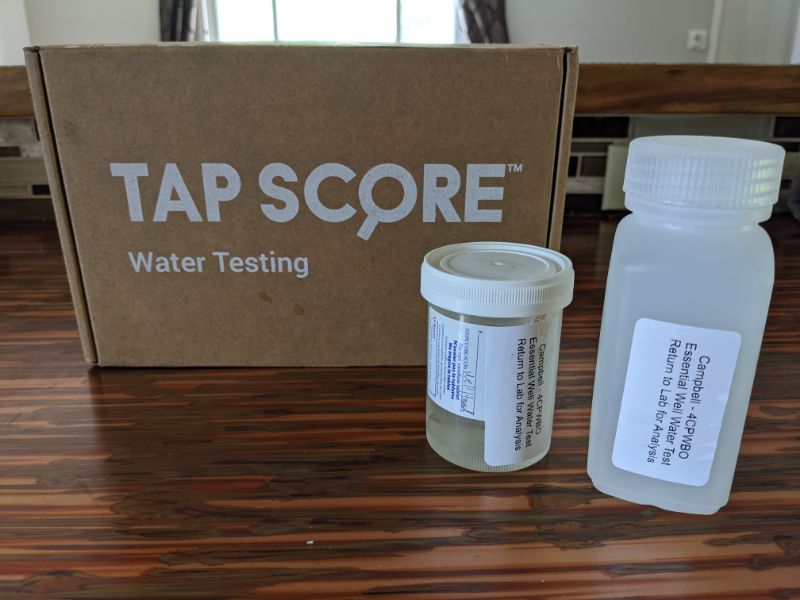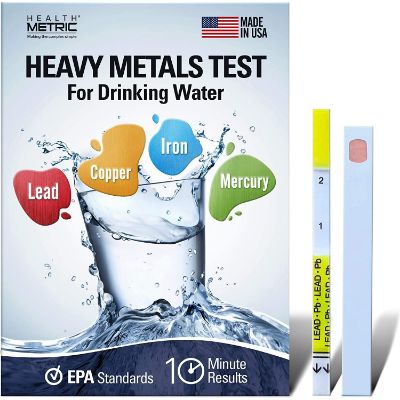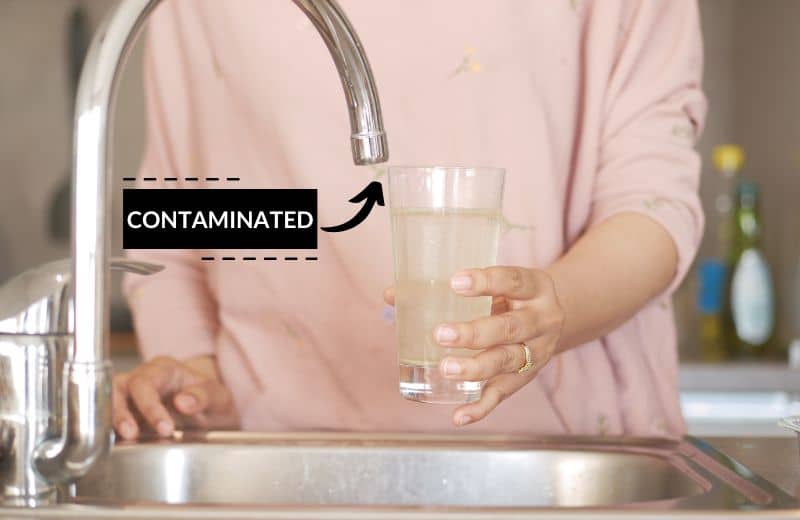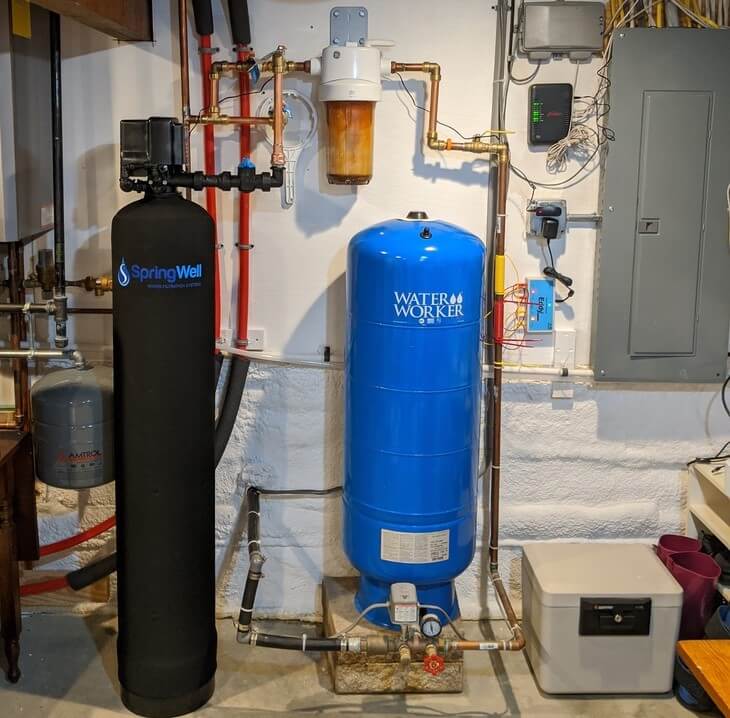Iron is one of the most common well water contaminants – unsurprising given that it makes up around 5% of the earth’s crust.
There are a few indications of iron in your water, including reddish-brown stains on your sinks and in your toilet, or water that has an orangey hue or smells rusty. But if you want to know how much iron your water contains, you need to look into methods of testing for iron.
In this guide, we’ve shared our top recommended tried-and-tested methods of testing for drinking water iron.

Table of Contents
🧪 Get Your Water Lab Tested
If you want to get a precise reading of iron in your water, it’s worth paying for certified laboratory testing. Many EPA-certified laboratories offer iron water testing.
You can either pay for a dedicated iron water test (costing around $45-$80) or upgrade to a grouped contaminant test that detects total iron and a number of related groundwater contaminants (costing around $90-$250, depending on the nature of the test).
Most labs also offer more in-depth testing options that detect various forms of iron – ferrous iron, ferric iron, and iron bacteria. These tests are useful if you want to determine exactly which type(s) of iron are present in your water supply, since different water treatment solutions address different iron types.
To conduct a lab test for iron in water, the laboratory will usually send you a sample taking kit. You can then hand over the testing process to the lab.
Here’s what the sample-taking process usually looks like:
- Choose your preferred iron water test.
- Wait for the sample kit to be sent to you, then collect water samples from your faucet in the provided vials.
- Post the samples to the laboratory.

You will usually receive your results from laboratory testing by email, within around 5 days. Your results will list the iron detected in your water, typically in PPM or mg/L, and how this compares to local/national legal limits/guidelines.
Laboratory testing is a lot more expensive than any other form of testing, but it’s also a lot more accurate.
Our recommended certified laboratory for water testing is Tap Score by SimpleLab. The Essential Well Water Test tests for iron in water, as well as other common well water contaminants, like aluminum, arsenic, copper, hardness minerals, lead, tannins, manganese, and zinc. Or, you can go for the Iron Water Test if you specifically want to test for total iron, or the Iron Speciation Water Test for an in-depth breakdown of the different types of iron present.
📥 Do a DIY Water Test
Not bothered about getting the most comprehensive results, and just want to get a rough idea of your water’s iron concentration? We recommend a DIY water test.
Test Strips For Iron Detection
At-home testing kits for iron typically use testing strips and a color chart. They’ll give you a range for the iron detected in your water, with most being able to detect between 0 and 200 PPM iron.
You can buy this type of DIY iron water test for as little as $20. Individual tests for iron are less common; you’re more likely to find grouped tests for a range of common water parameters and contaminants, including iron, total hardness, pH, mercury, lead, copper, manganese, fluoride, hydrogen sulfide, and more.
To test for iron in your drinking water with a test strips, follow these steps:
- Unbox your iron test and remove the test strips and color chart.
- Take a sample of your faucet water in a clean cup or container.
- Dip a strip in a sample of your water, then wait for the strip to change color.
- Compare the strip to the color chart to get a reading of your water’s iron levels.

Titration Test For Iron Detection
Titration tests for iron usually involve a colorimetric reaction, where specific reagents cause a color change in the presence of iron ions.
These tests aren’t as common as iron test strips, and they’re a bit more complex to use, but they’re still an affordable option worth considering.
Here’s how to test for dissolved iron in your drinking water with a titration reagent test:
- Collect a water sample from your faucet in a clean glass.
- Unbox the test kit and follow the manufacturer’s instructions to prepare the reagents.
- Add the prepared reagents to your water sample, again following the instructions and using precise measurements.
- Continue adding the reagents until your water changes color.
- Compare the color of your water to the included color chart. This should help you to determine the approximate iron content in your water sample.
At-home testing kits are a good choice if you’re just looking to get an idea of what your water contains, but the results won’t be exact (for example, you won’t be able to see if you have ferric or ferrous iron, or organic iron).
🚰 Observe a Glass of Water
If you want to find out whether or not your water contains iron right now, without having to buy a test first, try this method.
You may be able to check your water for iron by observing its color and any visible particles. Obviously, this doesn’t tell you how much water your iron contains, and it probably won’t show anything if your water’s iron levels are low.
To check for iron in a glass of drinking water, follow these steps:
- Fill a clear glass with water from the tap that you want to test.
- Examine the color of the water in the glass. If the water has a yellow, reddish, or rusty-colored tint, it could indicate the presence of iron.
- Let water sit undisturbed for a few minutes. If iron is present, you might see sediment, rust flakes, or other particles settling at the bottom of the glass.
- Smell the water to check for any metallic or earthy odors.
- Taste the water to check for a metallic taste.

You can conduct this test at any time, and it can help you to get a quick visual assessment of your water quality. But it won’t provide a precise measurement of your water’s iron levels and it’s not a comprehensive water analysis.
📝 Interpreting Your Results
Once you have your results, you can decide whether you’d benefit from installing a water treatment system to reduce the iron detected in your water.
While iron isn’t generally considered dangerous in the lower concentrations typically found in groundwater, elevated water iron levels can give water a poor taste and odor, leave iron stains on surfaces, cause issues in your plumbing, and affect your skin health. You might decide to take action if your water contains elevated iron concentrations that are causing aesthetic problems.
Iron is classed as a secondary contaminant by the Environmental Protection Agency (EPA), which has issued a secondary MCL of 0.3 mg/L based on its potential to have technical and aesthetic effects in water.
So, when you’re interpreting your results, you’ll probably want to address your water’s iron contamination if more than 0.3 mg/L of iron is detected.
Generally, iron isn’t detectable at lower levels than this, although the WHO says that color and turbidity may develop in plumbing with as little as 0.05–0.1 mg/L of iron present, and laundry may stain when iron concentrations exceed 0.3 mg/L.
If you do want to remove iron from your water, there are a few different water treatment systems we recommend:
- For removing low levels of dissolved ferrous iron (or clear water iron), a water softener may be the most suitable form of water treatment.
- To address higher concentrations of ferrous iron and ferric iron, you have the choice of KDF oxidizing filters, reverse osmosis filtration systems, air injection or chemical oxidation systems (e.g. hydrogen peroxide systems), and more.
- Sediment filters are a great choice for removing ferric iron, including rust flakes.
- For iron bacteria, the most effective solution is shock chlorination, followed by installing a suitable iron removal solution at your home’s main water line.

We’ve written a guide on how to remove iron from water that explains all the best water treatment solutions for iron removal, and when to use which system.
📑 Final Word
We wrote this guide because we wanted our readers to have access to a simple, helpful resource that explains the most effective iron testing methods for drinking water.
Hopefully, you’ve been able to use this guide to choose the most suitable iron test for your needs. Thanks for reading!

I use a shallow well to water my lawn. My driveway, side walks and the walls of my home are stained where the water hits a particular area. A year ago I purchased water siphoning system. The pump is attached to a 30 gallon tank and that is where I pour the Rid-O-Rust preventer. Obviously I’m not using the correct amount of product. I need to have my water tested to determine how many ppm of iron is contained in my well water. Where can I get my water tested. Do I have to purchase a test kit that would provide the data with how much product I need for a 30 gal tank. If I know the Iron data,the product manufacture can tell me how much product to use. I live in the Pinellas County Florida.
I would appreciate any help you could provide.
Nick Karay
Hey Nick, the most cost effective way to test for iron concentrations in your shallow well is to take a sample to your local county lab. Here’s the info for Pinellas county https://pinellas.floridahealth.gov/programs-and-services/environmental-health/water-programs/well-surveillance/index.html